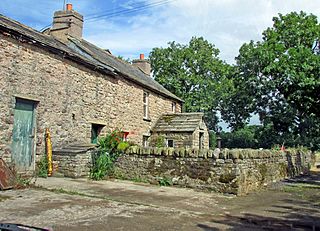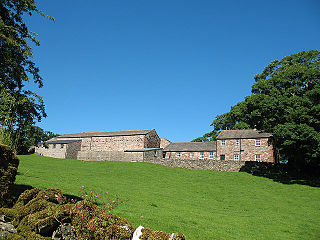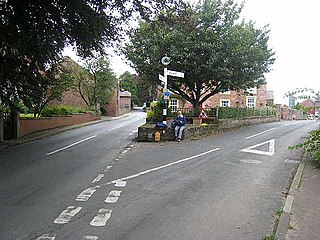
Ilmer is a village and former civil parish, now in the parish of Longwick-cum-Ilmer, in Buckinghamshire, England. It is at the foot of the Chiltern Hills about 3 miles (5 km) northwest of Princes Risborough, near the boundary with Oxfordshire. In 1931 the parish had a population of 40. On 1 April 1934 the parish was abolished to form "Longwick cum Ilmer".

Penrith is a market town and civil parish in the Westmorland and Furness district of Cumbria, England. It is less than 3 miles (5 km) outside the Lake District National Park and about 17 miles (27 km) south of Carlisle. It is between the Rivers Petteril and Eamont and just north of the River Lowther. The town had a population of 15,181 at the 2011 census. It is part of historic Cumberland.

Langwathby is a village and civil parish in northern Cumbria, and in the historic English county of Cumberland, about 5 miles (8 km) north east of Penrith on the A686 road. The village lies on the east bank of the River Eden. At the 2001 census the parish had a population of 748, increasing to 866 at the 2011 Census.

Great Salkeld is a small village and civil parish in the Eden District of Cumbria, England, a few miles to the north east of Penrith and bordering the River Eden. At the 2001 census the parish had a population of 445, decreasing to 412 at the 2011 Census.

Hunsonby is a village and civil parish in the Eden district of Cumbria, England, 7 miles (11 km) north east of Penrith. The parish is located 28 miles (45 km) south east of the city of Carlisle. Within the parish is the ancient stone circle of Long Meg and Her Daughters but not the nearby standing stone of Little Meg which is located near Langwathby. In 2011 the Census reported the parish to have a total population of 388.

Melmerby is a village and civil parish in the Eden district, in the county of Cumbria, England. It is a small village with a population of around 200. The village is 9 miles to the east of Penrith, a thriving community with immediate access to Junction 40 of the M6 motorway and a main line railway station serving London, Manchester, Edinburgh and Glasgow. Surrounded by countryside it sits between the North Pennines with its highest point, Cross Fell to the east and the World Heritage Lake District National Park 10 miles to the west. The River Eden is bridged about 4 miles (6.4 km) away at Langwathby, and Long Meg and Her Daughters, the 3,500-year-old stone circle – the second largest in the country – is nearby at Little Salkeld. In 1931 the parish had a population of 175.

Crosby-on-Eden is the combined name for two small villages, High Crosby and Low Crosby, within the civil parish of Stanwix Rural near Carlisle, in the Cumberland district, in the ceremonial county of Cumbria, England. It was formerly a parish in its own right under the name Crosby upon Eden. In 1931 the parish had a population of 238. On 1 April 1934 the parish was abolished and merged with Stanwix Rural, part also went to Wetheral.

Little Salkeld is a small village and former civil parish, now in the parish of Hunsonby, in the Eden district of Cumbria, England, a few miles to the north east of Penrith. In 1931 the civil parish had a population of 91.

Great Musgrave is a village and former civil parish, now in the parish of Musgrave, in the Eden district of Cumbria, England. It is about a mile west of Brough. In 1891 the parish had a population of 175.

Little Musgrave is a small village and former civil parish, now in the parish of Musgrave, in the Eden district of Cumbria, England. In 1891 the parish had a population of 52.

Hartley is a village and civil parish in the Eden district of Cumbria, England. It is about 0.5 miles (0.8 km) east of Kirkby Stephen. The area has many old lead and copper mines that are now abandoned as well as having a large quantity of iron haematite, ironstone and ore. At the highest peak in Hartley stand nine obelisks referred to as "Nine Standards". Nobody knows the true purpose of the "Nine Standards" although some believe that they were used to create a sense of a forthcoming army to scare the enemy forces. However, it is believed more heavily that they were placed as geographical aid to help outline the borders between the two neighbouring counties, Westmorland and Yorkshire. Hartley also is home to Hartley Castle. It was originally built as a "tower house circa 1353 and extended circa 1600" and then re- developed in the 18th century. The castle was built at the southern point of Hartley.
The Musgrave family was a prominent Anglo-Scottish Border family with many descendants in the United States of America, Australia and the United Kingdom a so-called Riding or Reiver clan of Cumberland and Westmorland. The earliest record of the Musgraves is Gamel, Lord of Musgrave, noted as being "of the county of Westmorland and divers manors in county Cumberland, living in the time of King Edward the Confessor (1042-1065) predating the Norman Conquest." The Musgraves though often Wardens of the West March during the times of the Reivers and among the fourteen most notorious of the reiving clans were known locally as de’ils (devils) dozen and consisted of the following families: Armstrong, Bell, Carleton, Dacre, Elliot, Graham, Johnstone, Kerr, Maxwell, Musgrave, Nixon, Routledge, Scott and Storey.

The "Luck of Edenhall" is an enamelled glass beaker that was made in Syria or Egypt in the middle of the 14th century, elegantly decorated with arabesques in blue, green, red and white enamel with gilding. It is now in the Victoria and Albert Museum in London and is 15.8 cm high and 11.1 cm wide at the brim. It had reached Europe by the 15th century, when it was provided with a decorated stiff case in boiled leather with a lid, which includes the Christian IHS; this no doubt helped it to survive over the centuries.

Kirkandrews-on-Eden or Kirkandrews-upon-Eden, in the past known as Kirkanders, is a village and former civil parish, now in the civil parish of Beaumont, in the Cumberland unitary authority area of Cumbria, England. The village is 4 miles northwest of Carlisle. Kirkandrews forms part of the Barony of Burgh together with the nearby villages Monkhill, Grinsdale, Rattlingate and Burgh-by-Sands. In 1931 the civil parish had a population of 145.

Grinsdale is a village and former civil parish, now in the civil parish of Beaumont, in the Cumberland district, in the ceremonial county of Cumbria, England, historically in Cumberland. Grinsdale has a church called St Kentigern's Church. It is the source of the surname. It is also beside the River Eden. The civil parish was merged into Beaumont on 1 April 1934. In 1931 the civil parish had a population of 161.

St Cuthbert's Church is located near the village of Edenhall, Cumbria, England. It is an active Anglican parish church in the deanery of Penrith, the archdeaconry of Carlisle, and the diocese of Carlisle. Its benefice has been united with those of seven local parishes to form the Cross Fell Group of churches. The church is recorded in the National Heritage List for England as a designated Grade I listed building. It stands to the southeast of the village, and is surrounded by parkland.

Kirkby Stephen Parish Church is a parish church of the Church of England, located in Kirkby Stephen, Cumbria. The church is sometimes called St Stephen's Church, possibly by analogy to the name of the town, but there is no evidence of a formal dedication to Saint Stephen. It is a Grade II* listed building.
Langwathby is a civil parish in the Eden District, Cumbria, England. It contains 27 listed buildings that are recorded in the National Heritage List for England. Of these, one is listed at Grade I, the highest of the three grades, one is at Grade II*, the middle grade, and the others are at Grade II, the lowest grade. The parish contains the villages of Langwathby and Edenhall and the surrounding countryside. In the earlier part of the 20th century the largest building in the parish was Eden Hall, but this was demolished in 1934. A number of listed buildings are associated with Eden Hall, including The Courtyard, West Lodge, and related structures. Most of the other listed buildings are houses and associated structures, farmhouses and farm buildings. The other listed buildings include churches, a medieval roadside cross, a public house, a railway viaduct, a war memorial, and a telephone kiosk.



















